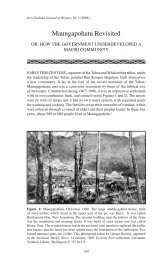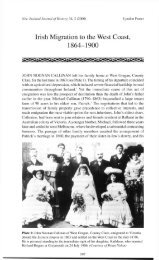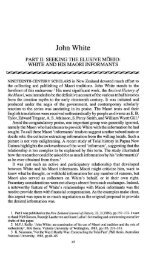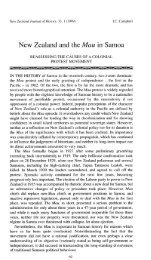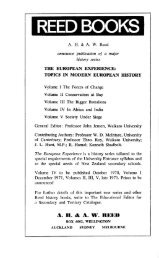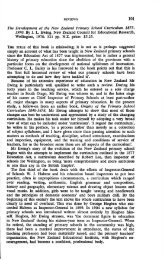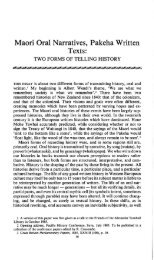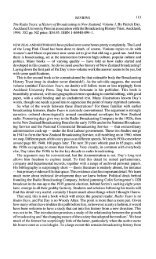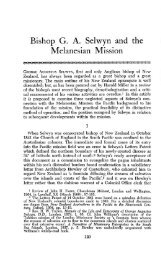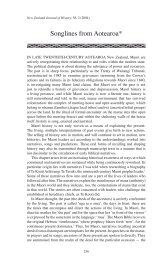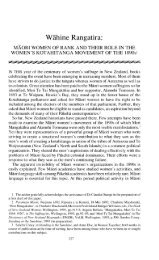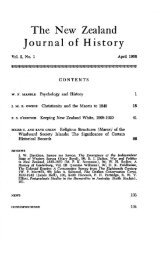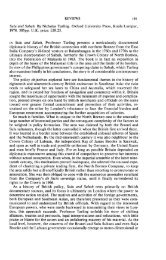Friendly Societies 1842-1938 - New Zealand Journal of History ...
Friendly Societies 1842-1938 - New Zealand Journal of History ...
Friendly Societies 1842-1938 - New Zealand Journal of History ...
You also want an ePaper? Increase the reach of your titles
YUMPU automatically turns print PDFs into web optimized ePapers that Google loves.
128 JENNIFER CARL YON<br />
to becoming a friendly society member than just paying the money and receiving<br />
the benefits. It meant becoming part <strong>of</strong> a mutually supportive group where the<br />
axioms <strong>of</strong> mutual help and responsibility for the well-being <strong>of</strong> others were<br />
obligations to be taken seriously. Every friendly society, without exception, was<br />
underpinned by this fundamental belief in the mutual assurance <strong>of</strong> the well-being<br />
<strong>of</strong> fellow-members and their families. The initiation ritual served as a kind <strong>of</strong><br />
baptism which formally marked the entrance <strong>of</strong> the member into the new group<br />
and introduced this new 'brother' or 'sister' to the rules and ethics <strong>of</strong> the society.<br />
Once initiated into one lodge, all the large affiliated societies such as<br />
MUIOOF, AOF, Druids and IOOF, allowed transferral <strong>of</strong> membership to<br />
another lodge <strong>of</strong> the same friendly society anywhere in <strong>New</strong> <strong>Zealand</strong> or overseas.<br />
Provided the member was up to date with contributions and had not transgressed<br />
any ethical code <strong>of</strong> the society, transferral <strong>of</strong> membership without losing any <strong>of</strong><br />
the accrued benefits was a simple and easy procedure. Given the particularly<br />
mobile colonial workforce and high level <strong>of</strong> immigration and emigration<br />
throughout the nineteenth century this transferability <strong>of</strong> benefits was essential to<br />
friendly society members.<br />
Contributions, benefits and conditions <strong>of</strong> payment varied from one friendly<br />
society to another, the most common practice being for a member to pay a<br />
combined contribution for the sickness and funeral benefit either fortnightly or<br />
monthly and, if they wished, a further sum for medical care. From the 1840s to<br />
the 1880s contributions were generally low and uniform, supplemented by a<br />
large initiation fee. The Fountain <strong>of</strong> Friendship Lodge, MUIOOF, Auckland,<br />
was a typical example. In 1844 contributions were fixed at sixpence weekly for<br />
all members regardless <strong>of</strong> age. The initiation fee was graduated according to age,<br />
with members under 21 paying 10s.6d., those under 30 years <strong>of</strong> age 15s., and<br />
those aged between 30 and 40 years paying 21s. By the late 1890s most friendly<br />
societies, under pressure from the registrar, 27 had introduced a graduated scale<br />
<strong>of</strong> contributions to the sick and funeral funds. While the amounts paid in<br />
contributions varied slightly from one society to another the average contribution<br />
in 1890 was sixpence a week for male members under 21, rising to Is. per<br />
week for members between 30 and 40 years old. By <strong>1938</strong> these contributions had<br />
risen very slightly to eightpence per week and Is.3d. respectively. 28 Female<br />
members paid less in the way <strong>of</strong> contributions and received correspondingly<br />
smaller benefits.<br />
27 Throughout the nineteenth, and well into the twentieth century, the Registrar <strong>of</strong> <strong>Friendly</strong><br />
<strong>Societies</strong> continually exhorted the societies to compile and use realistic tables <strong>of</strong> contributions and<br />
benefits, with the objective <strong>of</strong> becoming actuarially sound. By the end <strong>of</strong> the first decade <strong>of</strong> the<br />
twentieth century most <strong>of</strong> the larger societies had become solvent.<br />
28 Based on tables <strong>of</strong> contributions in Manchester Unity Independent Order <strong>of</strong> Oddfellows (<strong>New</strong><br />
<strong>Zealand</strong>) <strong>Friendly</strong> Society. Special Rules <strong>of</strong> the Auckland District, Auckland, 1944, pp.22-24.



